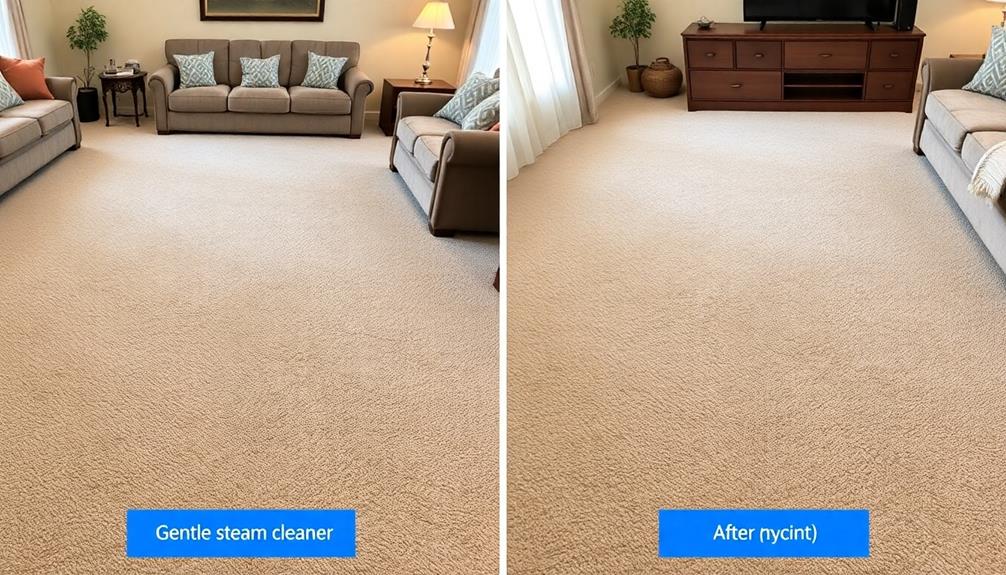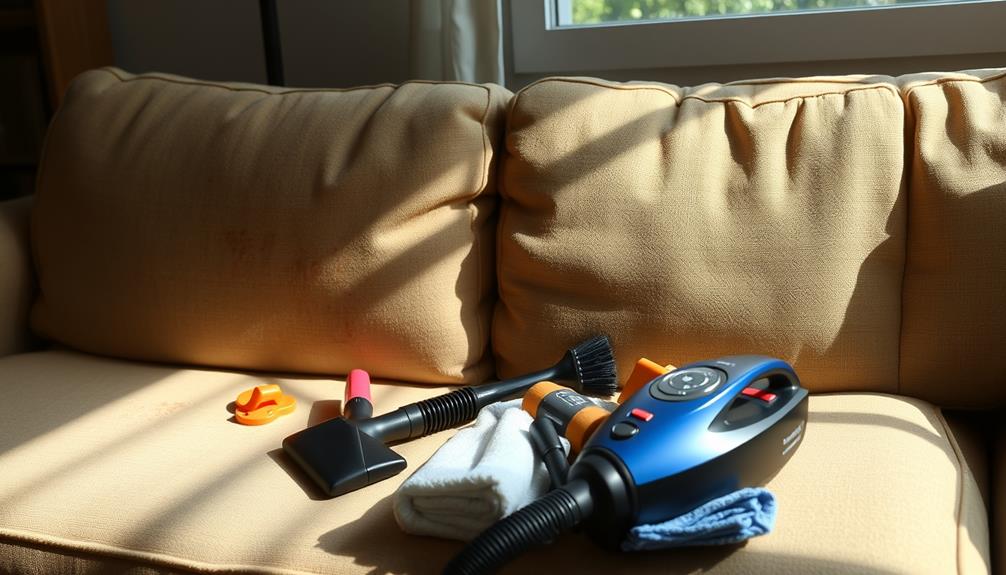To remove furniture marks from your carpet, start by assessing the depth of the dents. A simple technique using ice cubes works well—simply place ice cubes on the marks and allow them to melt. Then, fluff the carpet fibers with a spoon or your fingers. If that doesn’t work, consider using a hair dryer on a damp area or a steam cleaning method with a hot iron. In stubborn cases, professional cleaning may be the best solution. For effective strategies and prevention tips, continue reading to discover more ways to protect your carpet. Additionally, consider regularly rotating your furniture to prevent deep indentations from forming in the first place. Aside from dealing with carpet dents, homeowners often encounter the challenge of removing stains from fabric sofa surfaces. In both situations, taking prompt action and using the appropriate treatment can greatly impact the maintenance of your home’s appearance and the longevity of your furnishings.
Key Takeaways
- Use the ice cube method by placing ice cubes on indentations to help restore carpet fibers after they melt.
- Employ the steam cleaning technique by covering dents with a damp towel and using a hot iron for fiber rejuvenation.
- Try the hair dryer method by saturating the area with water and applying heat while fluffing fibers with your fingers.
- Regularly vacuum in multiple directions to lift flattened fibers and maintain carpet appearance and resilience.
- Prevent future dents by using furniture pads and periodically moving heavy items to allow carpet recovery.
Common Causes of Carpet Indentations
When you place heavy furniture on your carpet for an extended period, it can lead to unsightly indentations. These carpet dents form as the weight compresses the carpet fibers over time, causing them to lose their original shape.
Even if you rearrange your furniture regularly, the pressure can leave temporary marks that take a while to rebound. You might notice that some areas of the carpet are more affected, especially if the previous homeowners had heavy items in the same spots.
To maintain your carpet's appearance and longevity, consider regular cleanings with effective vacuums for dust removal that can help minimize allergens and dirt that may settle into the indentations.
Items with tapered or pointed legs exert more pressure on the carpet, leading to deeper indentations compared to those with flat bases. If you have an older carpet, it's more susceptible to permanent indentations due to the wear and tear it has experienced.
The age of the carpet means the fibers may not spring back as readily when the weight is removed, making it essential to be mindful about your furniture placement.
To avoid these issues, consider moving heavy furniture periodically and using protective pads under the legs to distribute weight more evenly across the carpet fibers.
Assessing the Damage
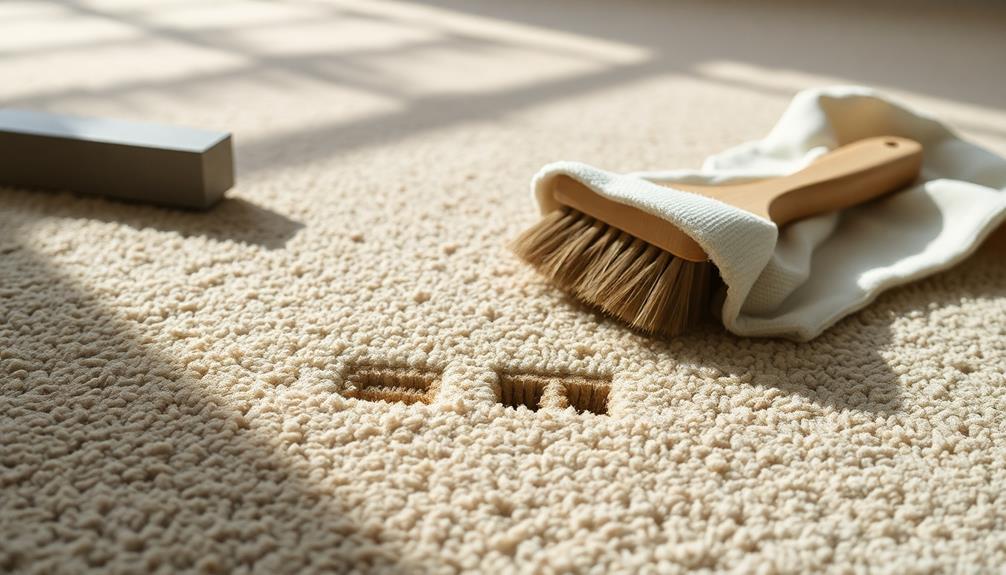
Before you plunge into any removal methods, it's crucial to evaluate the damage to your carpet. Start by inspecting the area where the furniture was placed. Look closely at the size and depth of the dents left behind. Deeper marks may require more intensive treatment, so take your time analyzing them.
Additionally, understanding the potential impact of moisture levels on your carpet can be advantageous, as it plays a role in how well the fibers recover. Consider reviewing resources on financial scams targeting seniors to protect vulnerable individuals from related issues.
Next, check the carpet material. Different fibers, like nylon or wool, can react differently to various removal methods. This will influence how you approach the restoration process.
It's also important to note how long the furniture has been in place; longer durations can lead to more permanent impressions that are tougher to fix.
Additionally, evaluate the overall condition of your carpet. Older or heavily worn carpets may be more susceptible to damage from weight, making recovery more challenging.
Finally, consider any other factors, such as moisture levels or any previous cleaning attempts. These can greatly affect the success of your chosen removal method.
Ice Cube Removal Method
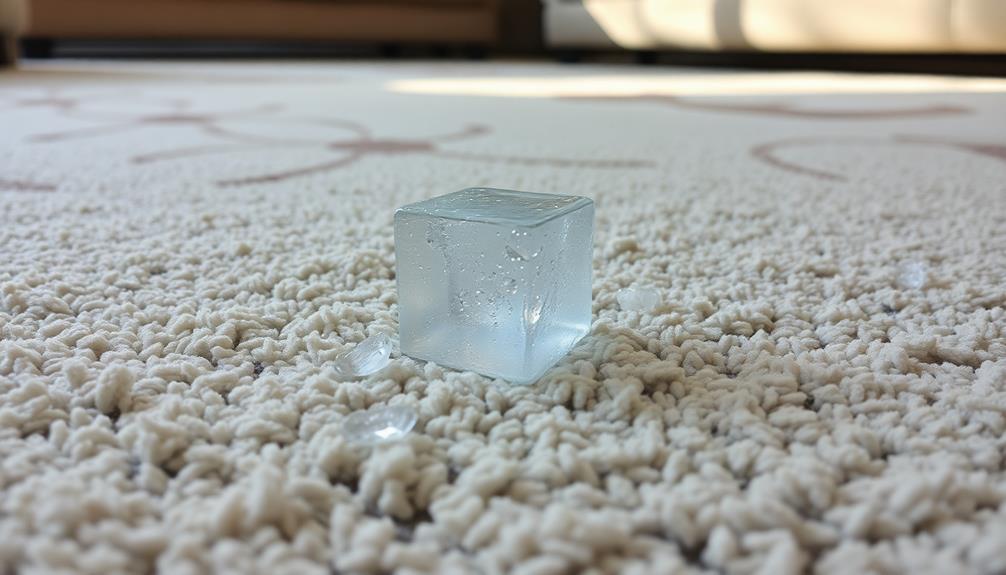
The ice cube removal method offers a simple yet effective way to tackle furniture marks in your carpet. To start, place several ice cubes directly on the dents in your carpet and let them melt over 8-10 hours. This process allows the fibers of your carpet to absorb moisture and expand, effectively helping to remove dents.
It's a good idea to regularly assess your home budget, as budgeting for home maintenance can guarantee you have the resources to address such issues promptly.
After the ice has completely melted, grab a damp towel or sponge to blot the excess water. This step is essential to prevent soaking and potential damage to your carpet backing.
Once you've blotted the area, gently fluff the carpet fibers using a spoon or your fingers. This will help restore their original height and texture, making your carpet look refreshed.
For best results, if any dents remain after the initial treatment, don't hesitate to repeat the process. This method works particularly well for newer carpets with minimal wear, as the moisture can easily rejuvenate the fibers.
With a little patience and care, you'll have your carpet looking as good as new in no time!
Steam Cleaning Technique
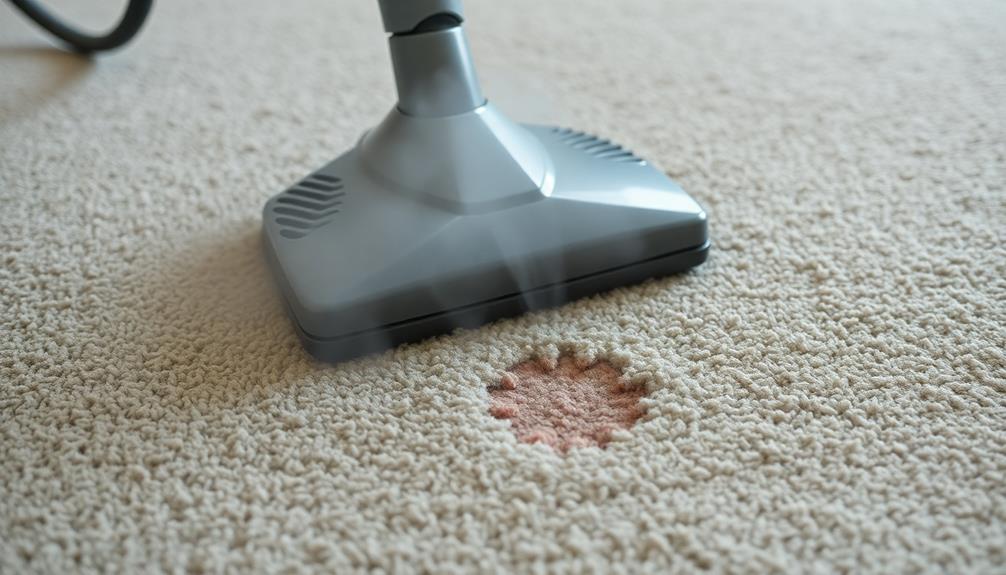
Using the steam cleaning technique can effectively lift furniture marks from your carpet, rejuvenating its appearance.
To start, cover the dent with a damp towel. This protects the carpet fibers during treatment. Next, grab a hot iron and set it to medium/high heat. Place the iron over the towel for 1-2 minutes. The steam will penetrate the carpet fibers, helping them to lift and restore their original shape.
It's essential to keep the towel between the heat source and the carpet. This prevents burns or damage to the fibers. After steaming, vacuum the area to enhance the recovery of the carpet fibers, further reviving their texture.
If you still see stubborn marks, don't hesitate to repeat the steaming process.
In some cases, you might find that your efforts aren't enough for deeper restoration. If that's the case, consider reaching out for professional carpet cleaning services. They've specialized tools and expertise to tackle tough marks, ensuring your carpet looks as good as new.
With these steps, you can easily maintain the beauty of your carpet and eliminate those pesky furniture marks.
Hair Dryer Method
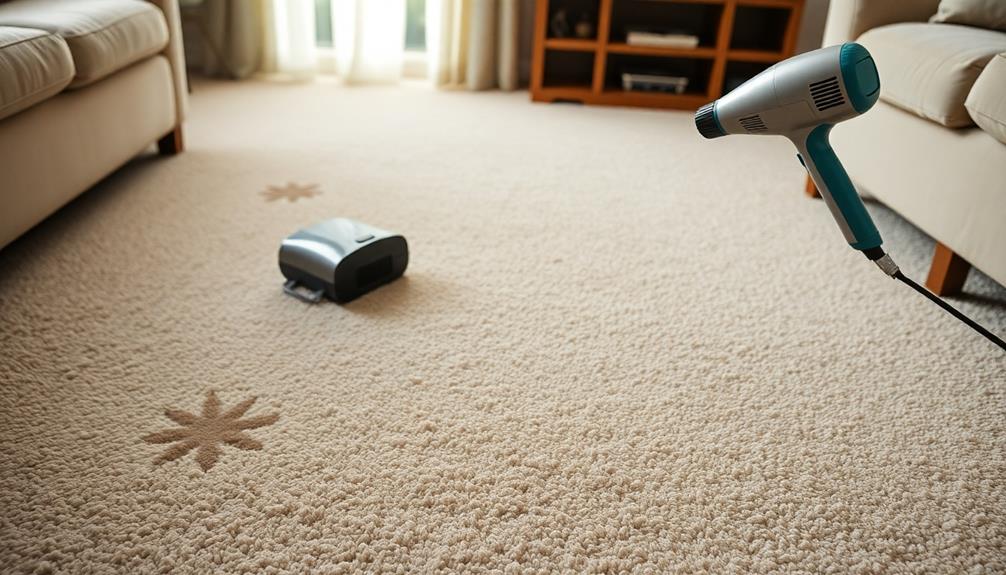
After trying the steam cleaning technique, you might want to explore another effective method for tackling furniture marks: the hair dryer method.
Start by saturating the indented area with water using a spray bottle. This step helps loosen the carpet fibers, making it easier to remove carpet dents.
Next, grab your hair dryer and set it to a high setting. Hold it about 4-6 inches away from the carpet, making sure to keep it moving. This prevents any one area from overheating, which could damage the carpet.
As you apply heat, gently fluff the carpet fibers with your fingers. This action aids in restoring their original shape and height. As the fibers regain their shape, be mindful not to overheat the area as excessive heat can damage the material. In some cases, you may need to repeat the process in order to fully recover the fibers’ texture. Similarly, when you’re tackling issues like removing dimethyl fumarate from sofas, it’s important to use appropriate methods and avoid harsh chemicals that could further harm the fabric.
Continue this process until the area is completely dry, which may take a few minutes depending on your carpet type and moisture level.
If the indentation is particularly stubborn, don't hesitate to repeat the process. With a little patience, the hair dryer method can effectively help you remove those pesky furniture marks, leaving your carpet looking fresh and revitalized.
Vacuuming for Indentation Removal
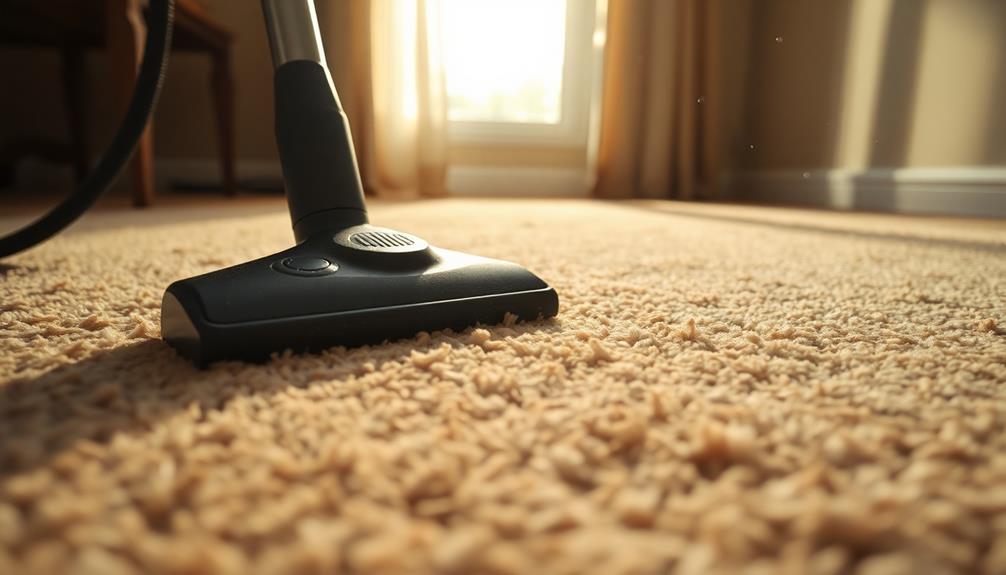
To start removing those pesky indentations, grab your vacuum cleaner with strong suction.
Use the hose attachment to target the affected area, which helps lift the carpet fibers more effectively.
This method works best on light marks, so make sure to vacuum in multiple directions for best results.
Initial Vacuuming Steps
A quick vacuuming can work wonders for lifting furniture marks out of your carpet. Start the indentation removal process by using your vacuum cleaner to lift and loosen the carpet fibers affected by those pesky marks. Before you begin, gently run your fingers through the indented area. This will help further loosen the fibers, making them more receptive to suction.
Next, attach the vacuum hose to focus on the indented areas. Use strong suction to help lift the flattened fibers back into place. If you're dealing with deeper indents, consider using a nozzle attachment that can provide concentrated suction on those specific areas. This targeted approach will maximize the effectiveness of your vacuuming efforts.
As you work, keep an eye on the progress. Sometimes, vacuuming alone mightn't fully restore the carpet. If that's the case, don't worry! You can always explore additional methods such as ice, steam, or heat treatments to further tackle stubborn furniture marks.
Proper Attachment Use
Properly using the right vacuum attachments can greatly enhance your efforts in removing furniture marks from your carpet. Start by grabbing your vacuum cleaner with a hose attachment; this will create strong suction on the indented areas, effectively loosening the carpet fibers.
Before you begin vacuuming, take a moment to gently lift and separate the carpet fibers around the furniture dents. This simple step can considerably boost your vacuum's effectiveness.
For best results, use a vacuum equipped with a beater bar or rotating brush feature. These attachments agitate the carpet fibers, promoting their lifting and helping to eliminate those stubborn indentations.
If the vacuuming alone doesn't completely remove the marks, don't hesitate to repeat the process or combine it with other techniques, like ice or steam methods, for better results.
Effectiveness on Light Marks
Many homeowners find that vacuuming is an effective first step for tackling light furniture marks on carpets. This method works by loosening the carpet fibers and helping to restore their original shape.
To maximize the effectiveness of vacuuming, gently rub the indented area with your fingers before you start. This action can help lift the fibers, making it easier for the vacuum to do its job.
Using a hose or upholstery tool with your vacuum cleaner allows for stronger suction, which specifically targets those indented areas for better results. Regular vacuuming not only helps address existing light marks but also prevents dirt accumulation, which can further compress carpet fibers and worsen indentations over time.
For the best outcome, incorporate vacuuming into your routine maintenance—aim for at least once a week. This simple practice keeps your carpets looking fresh and minimizes the appearance of furniture marks, allowing you to maintain a clean and inviting space in your home.
Preventing Future Dents
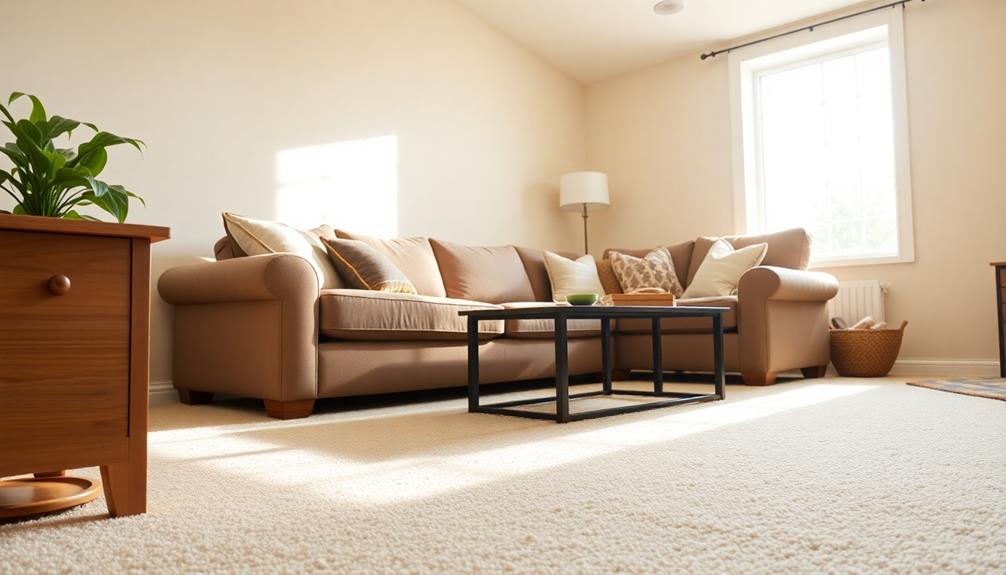
To prevent future dents in your carpet, consider using furniture pads under heavy items to evenly distribute their weight.
Regularly moving your furniture can also help the carpet fibers recover and avoid permanent indentations.
Taking these simple steps will keep your carpet looking fresh and dent-free.
Use Furniture Pads
One effective way to prevent future dents in your carpet is by using furniture pads. These pads, made of felt or rubber, help distribute the weight of your furniture evenly, considerably reducing the pressure on carpet fibers and preventing indentation. By placing furniture pads under heavy items like sofas or dressers, you maintain your carpet's appearance and extend its lifespan through minimal wear and tear.
Here's a quick overview of the types of furniture pads available and their benefits:
| Type of Furniture Pad | Benefits |
|---|---|
| Felt Pads | Soft, great for hardwood and carpet |
| Rubber Pads | Non-slip, ideal for heavy furniture |
| Furniture Coasters | Elevates legs, reduces pressure points |
| Adhesive Pads | Stays in place, easy to apply |
| Self-Stick Pads | Convenient for quick placement |
Regularly checking and replacing your furniture pads is essential for maintaining their effectiveness. Older pads may lose their grip, increasing the risk of dents. By investing in furniture pads, you're not just preventing future indentations, but also enhancing overall comfort underfoot.
Regularly Move Furniture
Using furniture pads can help prevent dents in your carpet, but regularly moving your furniture takes that protection a step further. By rearranging heavy items every 6 to 12 months, you allow carpet fibers to rebound and regain their original shape, minimizing the risk of permanent marks.
This simple action can greatly reduce the dents caused by heavy furniture over time.
Consider using lighter pieces or those with wider bases to lessen pressure points on your carpet. When it's time to move your furniture, always lift rather than drag to avoid creating new dents or damaging the carpet fibers.
Additionally, periodically rotating your area rug can help distribute wear evenly, further preventing the formation of dents.
This not only keeps your carpet looking fresh but also extends its lifespan.
Professional Cleaning Solutions
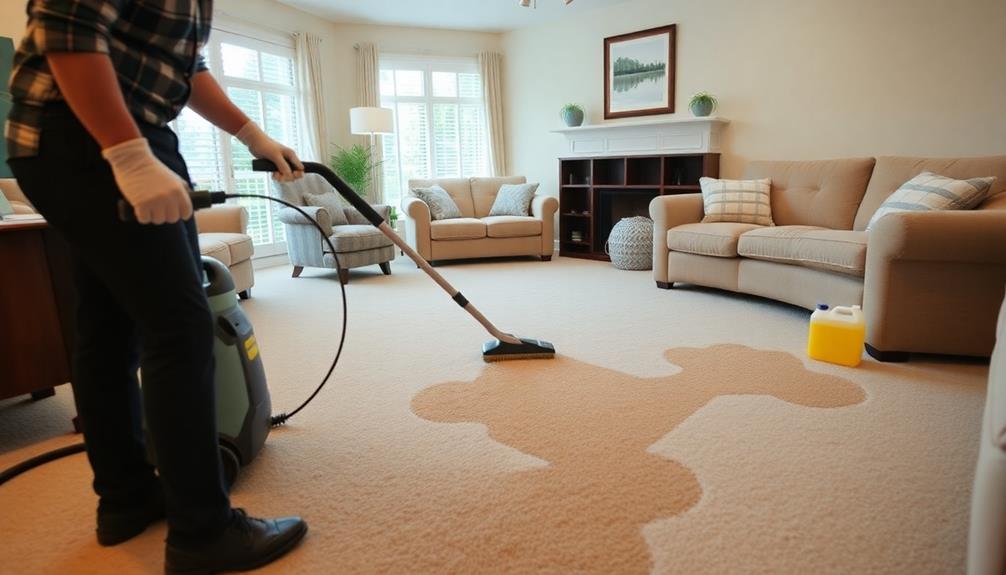
Professional carpet cleaning services offer an effective solution for lifting deep-set furniture marks and restoring your carpet's texture.
These experts utilize powerful truck-mounted equipment that can penetrate deep into the carpet fibers, effectively removing stubborn indentations caused by furniture. If you're dealing with persistent marks, consider opting for steam cleaning, a method commonly used by professionals. This technique applies heat and moisture, rejuvenating the carpet fibers and helping to eliminate those unwanted imprints.
Many professional cleaning companies also prioritize using environmentally-friendly products, ensuring a safe and thorough cleaning process without damaging your carpet.
Regular professional cleaning is recommended every 12-18 months to prevent dirt buildup and prolong the life of your carpets. By maintaining a clean environment, you can greatly reduce the likelihood of permanent furniture imprints.
When searching for a trusted local service, look for companies known for their high customer satisfaction, like Loudoun Carpet Care.
Their expertise in restoring carpets to their original condition can address both cleanliness and appearance, giving you peace of mind and a refreshed space.
Don't hesitate to reach out to a professional service for the best results!
Caring for Different Carpet Types
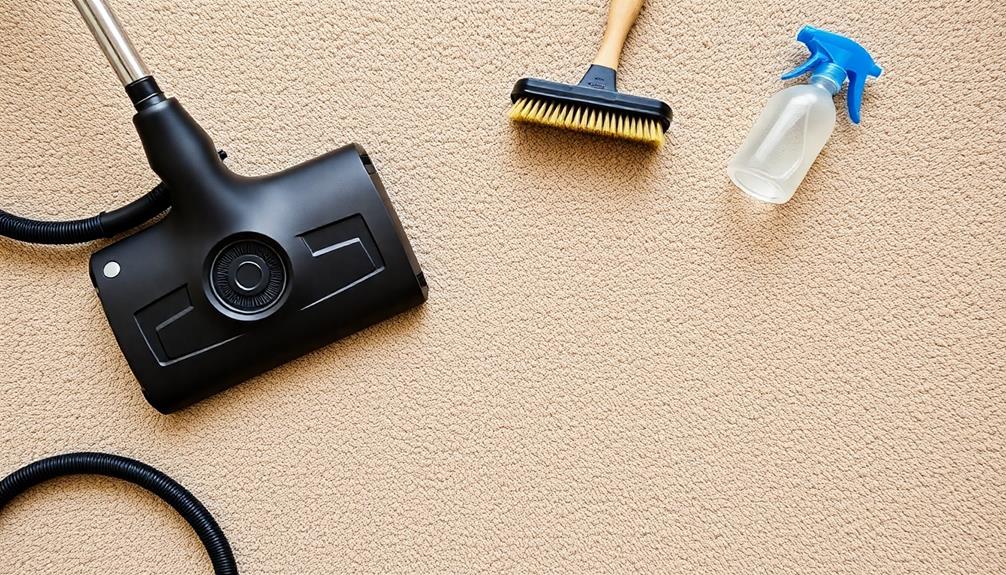
Caring for different carpet types requires tailored approaches to guarantee effective treatment and maintenance. Understanding whether your carpet is synthetic or natural fiber is vital for effective care. Here's a quick guide to help you:
| Carpet Type | Treatment Method | Maintenance Tips |
|---|---|---|
| Synthetic Carpets | Use ice cubes to lift dents; absorbent cloth protects flooring. | Regular vacuuming and raking. |
| Natural Fiber Carpets | Steam iron held above the carpet can lift fibers. | Avoid direct contact to prevent burns. |
Always check the carpet label to identify the material before applying any treatment, as different fibers react uniquely to cleaning methods. For synthetic carpets, the melting ice helps restore fibers, while for natural fibers, steam is effective but requires caution. Regular carpet maintenance, including vacuuming, is essential to keep fibers resilient and prevent long-term indentations. By knowing how to care for your specific carpet or rug type, you'll guarantee its longevity and maintain its appearance.
Additional Carpet Care Tips
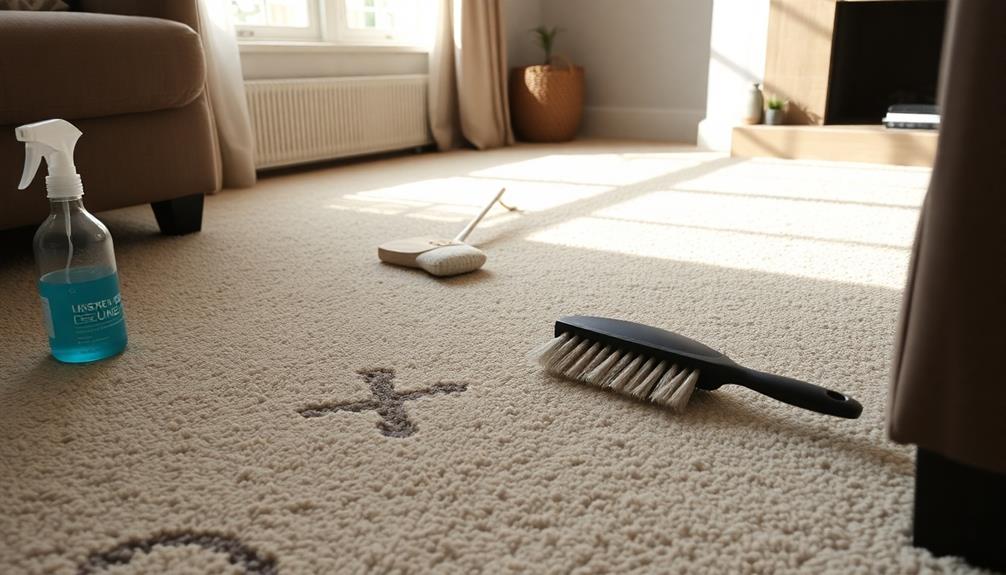
Maintaining the beauty and durability of your carpets involves more than just regular cleaning; it requires proactive measures to prevent damage. Start by vacuuming your carpets at least once a week. This helps maintain their appearance and texture while preventing dirt buildup that can lead to deeper indentations from furniture.
When spills occur, immediate spot cleaning is essential. Quick action can prevent stains and damage, as letting spills sit may result in permanent marks. Make sure you use appropriate cleaning products tailored to your carpet type to enhance both the longevity and appearance of your carpets.
Additionally, consider rotating area rugs every few months. This simple practice distributes wear evenly and helps avoid permanent indentations from heavy furniture.
Frequently Asked Questions
How Do You Get Furniture Indentations Out of Carpet?
To get furniture indentations out of carpet, you can use ice cubes, a damp towel with a heated iron, or a blow dryer. If those don't work, consider hiring a professional cleaning service for best results.
How Do You Raise Carpet Flattened by Furniture?
Picture your carpet, once plush, now flat under furniture's weight. You can restore its beauty! Try melting ice cubes, steaming with a damp towel, or blowing warm air while fluffing those fibers back into life.
How Do You Get Imprint Marks Out of Carpet?
To get those imprint marks out of your carpet, try using ice cubes to hydrate the fibers, or a damp towel with a warm iron. Vacuuming before and after helps restore the carpet's appearance too.
How Do Ice Cubes Remove Dents From Carpet?
Ice cubes remove dents from carpet by melting over time, saturating the fibers. As they absorb moisture, the fibers become pliable, allowing you to fluff them back to their original shape and texture.
Conclusion
Whether it's the stubborn imprint of your favorite chair or the fleeting memory of a festive gathering, carpet marks can be frustrating. Yet, with simple methods like the ice cube trick or a quick steam clean, those unsightly dents can vanish, leaving your carpet looking vibrant and fresh. Just as a well-tended garden flourishes, your carpet thrives with care and attention. So, embrace these techniques, and watch your space transform from dull to dazzling in no time.
